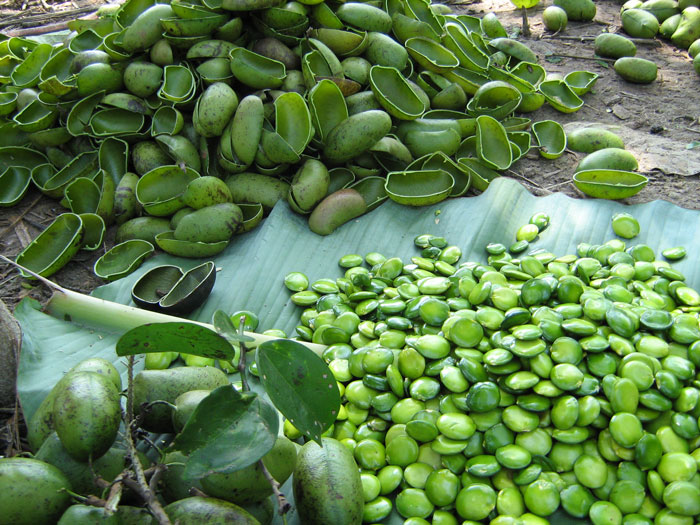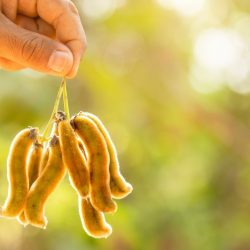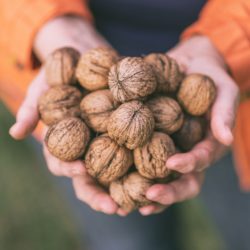When we hear about the griffonia for the first time, some country people will first think of hunting dogs, whether they are running or pointing, while urbanites will evoke canine breeds of amenities originating in Belgium. . Others, more focused on the marvelous and the fantastic , will immediately make reference to the griffin , this chimerical animal, a mixture of a lion on the back of the body, and an eagle at the level of the head, with wings and greenhouses. As long as we visualize it under a golden appearance, and we think of Gryffindor; here we are transported into the phantasmagoric universe of Harry Potter . All that’s missing is a little mandrake, and the magic is ready to operate …
A little history
Native to West Africa, griffonia grows naturally, in secondary and disturbed forest, and on the edge of primary forest, as a large liana with hairless brown-black twigs.
The populations of West Africa use this species as a medicinal plant but also as food . The pulp of the bark is used in particular as a poultice on wounds and the leaves are applied on burns . A decoction of the leaves is also used as a purgative while the juice would treat kidney and vesicular ailments , as well as eye inflammation . The root extract is used topically against sickle cell anemia . The seed, for its part, is renowned in particular for its aphrodisiac properties and is also used in diarrhea and stomach pain .
What are the main pharmacological properties of Griffonia pods?
Some studies have been carried out on the activity of 5-hydroxytryptophan (5-HTP), the main constituent of the seeds of Griffonia simplicifolia , an immediate precursor of serotonin in nervous tissue under the action of an enzyme, L-amino acid decarboxylase . The plant’s 5-HTP benefits from good bioavailability , and crosses the blood-meningeal barrier, which explains in particular to a large extent the therapeutic activity of the plant. Other studies have also focused directly on the plant itself.
Antidepressant property:
Observational studies and a few randomized trials have also shown that 5-HTP is of therapeutic interest in patients with mild to moderate depression . In vivo , in patients with unipolar and bipolar disorders , taking 5-HTP allowed an improvement of the disorders in 69% of cases without side effects. Comparison of the efficacy of a serotonin reuptake inhibitor ( fluvoxamine ) with that of 5-HTP demonstrated the equivalence of the 2 treatments from 2 weeks of administration in patients with depression.
Two open studies and a double-blind study carried out for 20 days in depressed patients did not show any difference between the intake of 5-HTP and that of imipramine , thus demonstrating the non-inferiority of 5-HTP vis-à-vis vis-à-vis this molecule.
In depressed patients, the combination of a tricyclic antidepressant and 5-HTP significantly improves the Hamilton test score, compared to a combination of chlorimipramine and placebo.
Anxiolytic and sedative property:
In vivo , the Griffonia simplicifolia seed extract exerts in particular an anxiolytic effect . In a study comparing 20 patients with panic disorder to 20 healthy patients, administration of 5-HTP prevented an increase in anxiety or depressive symptoms, and induced an increase in plasma levels of cortisol, β – plasma endorphin and melatonin, which makes sense since serotonin is metabolized to melatonin in the epiphysis.
Several studies have indeed demonstrated the hypnotic effect of 5-HTP. In normal patients, administration of 5-HTP significantly increases the duration of REM sleep. Likewise in moderately insomniac patients, low doses of 5-HTP significantly improve the duration and depth of sleep.
Satietogenic property:
An Italian team studied the effect on satiety of a griffonia extract administered for 4 weeks, at the same time as a low-calorie diet, in 20 overweight women . The results show a significant decrease in the sensation of appetite , body mass index (BMI) and arm and waist circumference in the treated group compared to the placebo.
Other studies have evaluated the effect of 5-HTP on eating behavior:
- In obese women (30 <BMI <40), taking 5-HTP compared to a placebo allows significant weight loss with a spontaneous decrease in the daily calorie intake (3220 Cal / d) and in particular in the intake of carbohydrates (50% decrease).
- Similarly, in patients with type 2 diabetes , taking 5-HTP compared to a placebo allows a significant reduction in calorie consumption (reduction in carbohydrate and fat intake) associated with weight loss. significant.
Anti-migraine property:
In migraine patients, taking 5-HTP for 6 months has the same efficacy as a reference anti- migraine medication ( methysergide ). 5-HTP also has efficacy comparable to a β-blocker, and significantly reduces the frequency of migraine attacks and the use of analgesics.
Action on fibromyalgia pain:
Dysfunction of the nociception modulation system appears to occur in fibromyalgia . In patients with fibromyalgia, reduced levels of serotonin metabolites in the cerebrospinal fluid have been described, indeed suggesting the implication of serotonin deficiency in the pathogenesis of the disease. At the same time, an evaluation of substance P, responsible for the increase in pain, was observed in the central nervous system as well as in the peripheral nerves.
In a study in fibromyalgia patients, the administration of 5-HTP for 30 days reduced the number of pain points and their intensity, as well as muscle stiffness when getting up and anxiety about the pain. placebo.
Another study showed that a combination of 5-HTP with a monoamine oxidase inhibitor (MAOI) is the most effective treatment for pain associated with fibromyalgia compared to a serotonin and norepinephrine reuptake inhibitor ( amitriptyline ) or a MAOI alone. In addition, administration of 5-HTP alone appears to be as effective as administration of the tricyclic antidepressant or MAOI alone.
Other properties:
In vitro , griffonia alkaloids exert cytotoxic activity on cancer cell lines.
Are there any precautions for use with Griffonia?
Contraindications:
- Griffonia is contraindicated in carcinoid tumors of the small intestine.
- Do not use in case of scleroderma.
- Contraindicated in pregnant or breastfeeding women, as well as in children or adolescents under 18 years of age due to the presence of alkaloids.
Precautions for use:
- Depending on the dosage and sensitivity of the person; 5-HTP used alone could therefore lead to reduced alertness and be dangerous when using machines or driving vehicles.
- Given the serotonergic mechanism of action of griffonia and the calming effect of griffonia, its use should be favored at the end of the day and in the evening , unless medical advice to the contrary.
- Long-term treatment with 5-HTP can cause seizures in people with Down’s syndrome.
Drugs interactions :
- Due to the presence of 5-HTP in griffonia, interactions are possible with plants such as St. John’s Wort or drugs that modulate the level of serotonin:
- Antidepressants: selective serotonin reuptake inhibitors, tricyclic antidepressants, etc. Their association with griffonia requires medical monitoring.
- Serotonin antagonists ( methylsergide )
- Avoid association with carbidopa ; Taking carbidopa and 5-HTP at the same time markedly increases the level of 5-HTP in the blood and may induce a scleroderma-like disease with increased kynurenine.
How to take Griffonia and in what dosage?
Dry form:
Liquid form:
- Standardized fluid extract of fresh plant : 5 to 15 ml per day in water. The content of 5-HTP, a tracer of plant activity, is approximately 70 mg per 5 ml.
Griffonia in masterly preparation of standardized extracts in liquid form (EPS)
In combination with passionflower :
In agitation, anxiety, irritability and hyperactivity, in particular in the evening, food compulsions, in particular towards sugary foods, addictions and difficult to fall asleep.
In combination with valerian :
For anxious rumination, anxiety with mental hyperactivity, compulsive or addictive behaviors, help with smoking or drug withdrawal (hypnotics, anxiolytics).
In combination with hawthorn :
Against irritability, hyperemotivity, hypersensitivity to stress, in particular with cardiac erethism and palpitations.
In association with lemon balm :
In the fight against visceral hypersensitivity and psychogenic abdominal pain.
In combination with mucuna :
In the use of a basic treatment of addictive behaviors, mixed depression (dopaminergic and serotoninergic) of mild to moderate intensity.
In association with rhodiola :
In irritability and hyperactivity with psychic overwork and beginning disorders of memory and attention and starting exhaustion
In combination with feverfew :
For the prevention of migraine attacks.
In association with the caralluma :
Against eating disorders and support for weight loss.
In association with licorice :
In the fight against fibromyalgia, diffuse somatic pain, especially in a context of intestinal hypermeability.
Medical bibliographic sources and clinical trials :
- Cangiano C. et al., Effects of oral 5-hydroxy-tryptophan on energy intake and macronutrient selection in non-insulin dependent diabetic patients; Int J Obes Relat Metab Disord., 1998
- Caruso I. et al., Double-blind study of 5-hydroxytryptophan versus placebo in the treatment of primary fibromyalgia syndrome; J Int Med Res., 1990
- Maissen C.P. et al., Comparison of the effect of 5-hydroxytryptophan and propranolol in the interval treatment of migraine. Schweiz Med Wochenshr, 1991
- Nardini M. et al., Treatment of depression with L-5- hydroxytryptophan combined with chlorimipramine, a double-blind study; Int J Clin Pharmacol Res., 1983
- Nicolodi M. et al., Fibromyalgia and migraine, two faces of the same mechanism. Serotonin as the common clue for pathogenesis and therapy, Adv Exp Med Biol., 1996
- Poldinger W. et al., A functional dimensional approach to depression ; serotonin deficiency as a target syndrome in a comparison of 5-hydroxytryptophan and fluvoxamine, Psychopathology, 1991
- Sano I., L-5-hydroxytryptophan (L-5-HTP) therapy, Folia Psychiatr Neurol Jpn., 1972
- Soulairac A. et al., Effect of 5-hydroxytryptophan, a serotonin precursor, on sleep disorders, Ann Med Psychol., 1977
- Soulairac A. et al., Etudes cliniques de l’action du précurseur de la sérotonine, le L-5-hydroxytryptophane, sur les troubles du sommeil; Schweizerische Rundschau für Medizin Praxis, 1988
- Titus F. et al., 5-Hydroxytryptophan versus methysergide in the prophylaxis of migraine. Randomized clinical trial, Eur Neurol., 1986
- Wang X.Z. et al., A new β-carboline alkaloid from the seeds of Griffonia simplicifolia, Chin J Nat Med., 2013
- Den Boer J.A. et al., Behavioral, neuroendocrine, and biochemical effects of 5-Hydroxytryptophan administration in panic disorder, Psychiatry Res., 1990
- Angst J., Woggon B., Schoepf J., The treatment of depression with L-5-Hydroxytryptophan versus imipramine. Results of two open and one double-blind study, Arch Psychiatr Nervenkr, 1977
- Lemaire P.A. et al. An HPLC method for the direct assay of the serotonin precursor, 5-Hydroxytryptophan, in seeds of Griffonia simplicifolia, Phytochem Anal., 2002
- Sternberg E.M. et al., Development a scleroderma-like illness during therapy with L-5-Hydroxytryptophan and carbidopa, N Engl J Med., 1980





